Self-adhesive cork offers easier installation and better adhesion for various surfaces compared to plain cork, which requires separate gluing. It provides a cleaner and more convenient solution for DIY projects and soundproofing. Plain cork, while versatile, often demands additional preparation and tools to secure it effectively.
Table of Comparison
| Feature | Self-Adhesive Cork | Plain Cork |
|---|---|---|
| Installation | Easy peel-and-stick application, no glue needed | Requires separate adhesive for installation |
| Surface Finish | Pre-attached adhesive allows smooth, uniform application | Flexible surface options, depends on adhesive quality |
| Durability | Moderate; adhesive may weaken over time | High; stable with proper adhesive and sealing |
| Use Cases | Ideal for quick DIY projects, wall panels, crafts | Best for flooring, large area insulation, professional projects |
| Cost | Generally higher due to integrated adhesive | Lower base material cost, but added adhesive expense |
| Thickness Options | Limited; usually thinner sheets | Wide range; from thin sheets to thick slabs |
Introduction to Cork: Self-Adhesive vs. Plain
Self-adhesive cork combines natural cork's insulation and durability with an easy peel-and-stick backing that simplifies installation for DIY projects and quick applications. Plain cork sheets require separate adhesives but offer greater flexibility for custom cuts and various bonding methods in flooring, wall panels, and crafts. The choice between self-adhesive and plain cork depends on project scale, surface type, and desired convenience versus customization.
Key Differences Between Self-Adhesive and Plain Cork
Self-adhesive cork features a pressure-sensitive backing that simplifies installation by eliminating the need for additional adhesives, making it ideal for quick DIY projects and temporary applications. Plain cork requires separate adhesive application, offering stronger and more permanent bonding suitable for flooring, wall coverings, and soundproofing in high-traffic areas. The moisture resistance and durability of both types vary based on treatment, with self-adhesive cork generally less robust for heavy-duty use compared to professionally installed plain cork tiles or sheets.
Installation: Self-Adhesive Cork vs. Plain Cork
Self-adhesive cork offers a significantly quicker installation process compared to plain cork, as it comes pre-coated with a pressure-sensitive adhesive backing that eliminates the need for additional glue or nails. Plain cork typically requires the application of a separate adhesive, precise alignment, and longer curing times, which can extend installation duration and complexity. In projects where time efficiency and ease are priorities, self-adhesive cork provides a practical advantage without compromising durability or aesthetic appeal.
Versatility and Applications of Self-Adhesive Cork
Self-adhesive cork offers enhanced versatility compared to plain cork, enabling easy installation on various surfaces without the need for additional adhesives or tools. Its strong adhesive backing makes it ideal for applications such as wall coverings, bulletin boards, coasters, and drawer liners, providing both aesthetic appeal and functional cushioning. This convenience extends its use to DIY projects and commercial environments, where quick, clean, and durable mounting solutions are essential.
Common Uses of Plain Cork Sheets
Plain cork sheets are widely used in insulation for walls, floors, and ceilings due to their excellent thermal and acoustic properties. They serve as protective underlayment in flooring installations and are popular for craft projects, bulletin boards, and coasters. The natural, untreated surface of plain cork makes it ideal for applications where customization, like painting or cutting, is required.
Durability and Lifespan Comparison
Self-adhesive cork offers enhanced durability due to its built-in adhesive layer, which provides strong bonding to surfaces and reduces the risk of peeling or lifting over time. Plain cork, while naturally resilient and moisture-resistant, requires external adhesives that may degrade faster, potentially shortening its effective lifespan. Studies indicate that self-adhesive cork can maintain structural integrity up to 30% longer in high-traffic or humid environments compared to traditional cork applications.
Cost Analysis: Self-Adhesive Cork vs. Plain Cork
Self-adhesive cork generally incurs a higher initial cost compared to plain cork due to the added adhesive layer and manufacturing complexity. While plain cork requires separate adhesive application, which may increase labor costs and installation time, self-adhesive cork tends to reduce overall installation expenses despite its premium price. Evaluating the total cost of ownership, including materials, labor, and installation efficiency, is essential for an accurate cost analysis between self-adhesive and plain cork options.
Maintenance and Care for Cork Materials
Self-adhesive cork offers easier installation and lower maintenance since it resists lifting and peeling compared to plain cork, which often requires additional adhesives and regular sealing to prevent moisture damage. Both types benefit from gentle cleaning with a damp cloth and avoidance of harsh chemicals to preserve their natural texture and durability. Maintaining optimal indoor humidity levels also helps prevent warping and cracking in cork materials.
Environmental Impact and Sustainability
Self-adhesive cork typically involves a synthetic adhesive layer that can hinder the material's biodegradability and recycling potential compared to plain cork, which is fully natural and compostable. Cork harvesting remains sustainable since it is harvested from the bark of cork oak trees without harming them, but the environmental footprint increases with added adhesives and manufacturing processes in self-adhesive variants. Plain cork offers superior environmental benefits by being renewable, biodegradable, and requiring minimal processing, making it the preferred choice for eco-conscious applications.
Choosing the Right Cork: Self-Adhesive or Plain?
Self-adhesive cork offers easy installation and strong adhesion, making it ideal for quick projects, while plain cork requires additional adhesive but provides greater flexibility in application and customization. Choosing between self-adhesive and plain cork depends on factors such as surface type, desired durability, and installation speed. For long-term use on uneven or porous surfaces, plain cork allows better adjustment, whereas self-adhesive cork suits smooth, clean surfaces for immediate deployment.
self-adhesive cork vs plain cork Infographic

 materialdif.com
materialdif.com